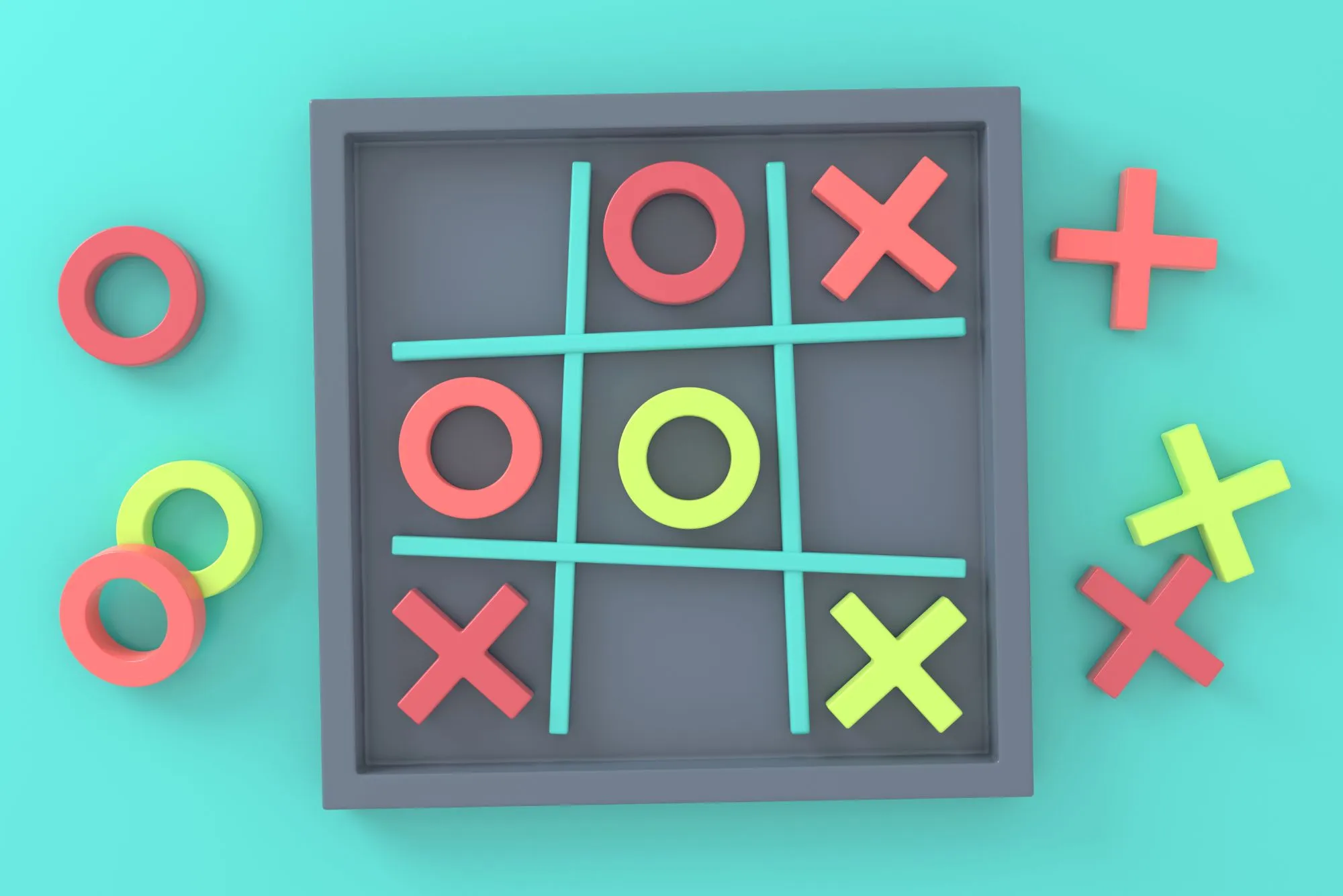Tic Tac Toe is a classic and straightforward game that has been entertaining players for generations. Whether you’re new to the game or looking to improve your skills, understanding the steps and strategies behind Tic Tac Toe can help you play better and enjoy the game more. This guide covers how to play Tic Tac Toe, with easy steps and helpful tips to give you the edge.
What is Tic Tac Toe?
Tic Tac Toe, also called “Noughts and Crosses,” is a two-player game played on a simple 3×3 grid. The goal is to place three of your symbols, either “X” or “O,” in a straight line horizontally, vertically, or diagonally before your opponent does. It’s a game of strategy, requiring quick thinking and the ability to anticipate your opponent’s moves.
What is Tic-Tac-Toe? A Detailed Exploration
Tic-Tac-Toe is a classic and simple strategy game that has been played for centuries. Known for its easy-to-understand rules and quick gameplay, it is often one of the first games children learn. Despite its simplicity, Tic-Tac-Toe is a game of strategy, requiring players to think ahead and anticipate their opponent’s moves. This article will explore the game’s rules, history, strategies, and its relevance in both casual play and academic study.
Tic-Tac-Toe: The Basics
Tic-Tac-Toe is a two-player game played on a 3×3 grid. One player uses “X” and the other uses “O” as their marks, and the goal is to get three of your marks in a row, either horizontally, vertically, or diagonally.
How to Play
Game Setup:
The game begins with an empty 3×3 grid.
Taking Turns:
Players take turns marking an empty square on the grid. The player who is using “X” typically goes first.
Winning the Game:
The first player to align three of their marks (X or O) in a horizontal, vertical, or diagonal row wins the game.
Draw/Tie Game:
If all nine squares are filled without either player achieving three in a row, the game ends in a tie, often called a “cat’s game.”
History of Tic-Tac-Toe
Tic-Tac-Toe is believed to have ancient origins, with variations of the game played by different civilizations.
Early Origins
Ancient Egypt:
Archaeologists have found evidence of similar grid-based games scratched onto stone slabs in ancient Egyptian ruins, dating back to around 1300 BCE.
Roman Empire:
A game known as terni lapilli, played by the Romans around the first century, is often cited as a precursor to modern Tic-Tac-Toe. The game was played on grids, and the rules were very similar to today’s version.
The Name “Tic-Tac-Toe”
The term “Tic-Tac-Toe” first appeared in the United States in the mid-19th century. The name may have derived from the sound of pencil marks being made during play. In Britain, the game is often called Noughts and Crosses, reflecting the use of “nought” (meaning zero) and “cross” (representing X).
The Strategy of Tic-Tac-Toe
Despite being a simple game, Tic-Tac-Toe involves a basic level of strategy, especially when played competitively. As players become more experienced, they learn how to predict their opponent’s moves and block potential winning lines.
First Move Advantage
The player who goes first has a slight advantage in Tic-Tac-Toe, as they have the first chance to claim a spot on the grid. Typically, experienced players will start by marking the center square, as it offers the most opportunities to form a winning line.
Offensive and Defensive Play
Offense:
The key to winning Tic-Tac-Toe is to always be on the lookout for a winning combination. If you can create a line of two marks with the potential to win on the next turn, you put pressure on your opponent to block you.
Defense:
Just as important as creating your own winning lines is blocking your opponent from completing theirs. Always anticipate your opponent’s moves and block them whenever necessary.
The “Unbeatable” Strategy
Tic-Tac-Toe can be “solved,” meaning that if both players use the optimal strategy, the game will always end in a draw. This occurs because the game’s limited board size and straightforward rules leave no room for mistakes at the highest level of play. A common optimal strategy for the first player is to start by marking the center square.
Common Winning Patterns
Horizontal:
Three marks aligned across any row (e.g., top row: X X X).
Vertical:
Three marks aligned in a vertical column (e.g., middle column: X X X).
Diagonal:
Three marks aligned diagonally across the grid (e.g., top-left to bottom-right).
Variants of Tic-Tac-Toe
While the 3×3 grid version is the most common, there are several variations of Tic-Tac-Toe that add complexity or change the structure of the game.
4×4 and Larger Grids
Larger grids, such as 4×4 or even 5×5, add more complexity to the game. In these versions, players may need to get four or five marks in a row, depending on the rules. Larger grids allow for more strategic depth and reduce the likelihood of the game ending in a draw.
Misère Tic-Tac-Toe
In this variation, the goal is to avoid making three in a row. The game is played exactly like regular Tic-Tac-Toe, but the winner is the first player to force their opponent to complete a line of three marks.
3D Tic-Tac-Toe
This variation is played on multiple layers of 3×3 grids stacked on top of one another, creating a 3D game board. The goal is still to make three in a row, but the lines can now be formed across different levels, adding a new dimension to the strategy.
Tic-Tac-Toe in Popular Culture and Technology
Tic-Tac-Toe and Computers
Tic-Tac-Toe was one of the first games to be programmed on early computers. Due to its simple rules and small grid size, it was a perfect choice for demonstrating the basic principles of artificial intelligence (AI) and game theory.
AI and Game Theory
The simplicity of Tic-Tac-Toe allows for algorithms to “solve” the game, ensuring that a computer can never lose if it plays optimally. The game became an early example of AI capabilities.
Human-Computer Interaction:
Tic-Tac-Toe is often used to teach basic programming concepts in educational settings, allowing students to create a simple game with minimal coding knowledge.
Tic-Tac-Toe in Entertainment
Tic-Tac-Toe frequently appears in pop culture, often as a way to symbolize simple problem-solving or to represent a child’s game. For example, the game appears in movies, TV shows, and even advertisements, sometimes as a way to signify a character’s intelligence or naiveté.
Educational Value of Tic-Tac-Toe
Tic-Tac-Toe is more than just a time-passing game; it offers several educational benefits, especially for young children:
Critical Thinking:
The game encourages players to think ahead, plan their moves, and anticipate their opponent’s actions.
Pattern Recognition:
Players learn to recognize winning patterns and develop spatial awareness.
Basic Logic and Strategy:
Tic-Tac-Toe introduces basic strategic concepts that are foundational in more complex games, teaching the value of both offense and defense in competitive play.
Tic-Tac-Toe is a timeless and universal game that appeals to all ages, from children to adults. Its simplicity makes it easy to learn, yet its strategic depth ensures that players of all levels can enjoy it. Whether played casually, in a classroom setting, or used in computer science to explore artificial intelligence, Tic-Tac-Toe remains a valuable and enduring game in the world of entertainment and education.
Basic Rules of Tic Tac Toe

The game is played on a grid of nine squares. One player selects “X” as their symbol, while the other player uses “O.” Traditionally, the player using “X” starts the game. The two players take turns marking one of the empty squares with their symbol, and the first player to form a row of three symbols wins the game. If all nine squares are filled without a winner, the game ends in a draw, often referred to as a “cat’s game.”
Step-by-Step Guide to Playing Tic Tac Toe
To play Tic Tac Toe, the first thing you need to do is draw a 3×3 grid with two vertical and two horizontal lines, creating nine equal spaces. After deciding which player goes first, the game begins. The first player marks an “X” in any one of the squares. The second player follows by marking an “O” in one of the remaining spaces. The players take turns marking the grid until one player forms a row of three symbols in a line, either vertically, horizontally, or diagonally. If neither player manages to create a winning line and all spaces are filled, the game is a tie.
Common Strategies for Tic Tac Toe
Starting the game in one of the corners can significantly improve your chances of winning. If you begin in a corner, you create more opportunities to form a row of three symbols, since corners allow you to build in multiple directions. Another powerful move is to control the center. If you place your symbol in the middle of the grid, you can extend your line in any direction, which maximizes your chances of winning and makes it harder for your opponent to block you.
As the game progresses, it’s important to watch your opponent’s moves carefully. Blocking their attempts to form a row of three is critical to staying in the game. At the same time, focus on creating multiple opportunities for yourself to win. By positioning your symbols so that you have two potential ways to complete a line, you force your opponent to make difficult decisions.
Advanced Tips for Tic Tac Toe

A useful tactic in Tic Tac Toe is to play symmetrically. If your opponent places their mark in a corner, you can respond by mirroring their move on the opposite side. This strategy keeps the game balanced and prevents your opponent from gaining an advantage. Another effective strategy is creating a “fork.” A fork occurs when you place your symbol in such a way that it sets up two possible lines of three symbols on your next turn. Your opponent can only block one of these, allowing you to win with the other.
In addition to creating forks, it’s also essential to recognize when your opponent is setting one up. If you spot a potential fork, you should prioritize blocking it to prevent them from gaining a winning opportunity. Also, avoid making moves that serve no strategic purpose. Every placement on the grid should either help you win or block your opponent from winning. Careless moves can give your opponent the upper hand.
When the game reaches its final stages, especially if both players are highly skilled, the goal often shifts from winning to forcing a draw. If no clear winner emerges, focus on filling the remaining spaces to prevent your opponent from completing a line.
Variations of Tic Tac Toe
Although the standard 3×3 version is the most widely played, several variations of Tic Tac Toe exist to add complexity and keep the game fresh. One variation uses a larger grid, such as 4×4 or 5×5, where the objective is to align four or five symbols in a row instead of three. This version requires more advanced strategy and foresight, as the game lasts longer and offers more opportunities for both players to win.
Another interesting variation is 3D Tic Tac Toe, which is played on a 3x3x3 grid, creating a three-dimensional game space. Players must visualize lines extending through three layers of the grid, which adds a new dimension to the game and makes it much more challenging.
Ultimate Tic Tac Toe is another popular variant where the game is played on a grid of nine smaller Tic Tac Toe boards. Each move made on one of the smaller boards determines where your opponent can play next on the larger grid. The game requires even more strategic thinking as players must win the smaller boards to dominate the larger one.
Tic Tac Toe is a timeless game that is easy to learn but offers plenty of room for strategic play. Understanding how to use the corners, control the center, block your opponent, and create multiple winning opportunities can drastically improve your chances of success. As you become more skilled, advanced tactics like forks and symmetry come into play, offering new layers of strategy. By mastering these techniques and trying out variations of the game, you can keep Tic Tac Toe engaging and competitive for years to come.









